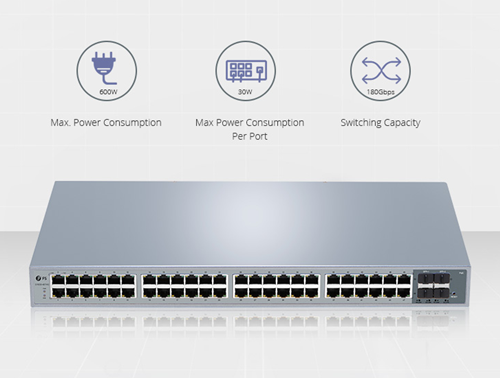48 Port PoE Switch: Cisco Vs HP Vs FS.COM
To meet the growing requirement of an improved enterprise network management, 48 port PoE switch provides optimized solution for network efficiency, operational cost savings, and ease of management. Cisco always plays a leading role in fiber optical communication while HP switches are renowned for competitive price, quality and service. FS.COM is seen as the rising third-party fiber optics’ vendor. It has gained well reputation for their fiber optical transceiver, fiber jumpers, etc. Today, we would touch the basic introduction of the 48 port PoE switch supplied by these three vendors, analyze the difference, and provide a selection guide.
Cisco 48 Port PoE switch
For Cisco 48 port PoE switch, there are many such switches having been launched, such as SG 500X-48P(170/volume per month), SG2010P(210/volume per month), etc. The Cisco SG2010P 48 port poe switch has 48 RJ-45 connectors for 10BASE-T/100BASE-TX/1000BASE-T with 4 Gigabit combo ports shared between mini-GBIC ports. It is optimized for maximum system availability, with fully redundant stacking, redundant power options, and dual images for resilient firmware upgrades. The enhanced quality of service (QoS) and traffic-management features help ensure clear and reliable voice and video communications. The distinctive features of the Cisco SG2010P 48 port poe switch are showing in the below:
- IEEE 802.3af PoE delivered over any of the forty-eight 10/100/1000 ports
- Dual images for resilient firmware upgrades
- 96 Gbps nonblocking, store-and-forward switching capacity
- Fully resilient stacking provides optimized growth with simplified management
- ACLs for granular security and QoS implementation
- Configuration and monitoring from a standard web browser
HP 48 Port PoE switch
HP also offers many 48 port gigabit poe switch, such as HP J9853A(50/volume per month), HP 2530-48G(1300/volume per month), HP 2530-48G... HP 2530-48G is the hottest one among all the HP 48 port gigabit poe switches. The HP 2530-48G (J9775A) switch 48 RJ-45 auto-sensing 10/100/1000 ports (IEEE 802.3 Type 10BASE-T, IEEE 802.3u Type 100BASE-TX, IEEE 802.3ab Type 1000BASE-T) and four small form-factor pluggable (SFP) slots for fiber connectivity. The HP 2530-48G 48 port gigabit poe switch consists of four fully managed Layer 2 edge switches, delivering cost-effective, reliable, and secure connectivity for business networks.
FS.COM 48 Port PoE switch
Different from Cisco and HP, the total volume of FS.COM 48 poe switch is far less than Cisco and HP. For FS.COM 48 port poe switch, it offers S5800-48F4S, S3800-48T4S, S5850-48T4Q, and etc. S5800-48F4S 48 port poe switch is a availability, high-compatibility and network-scaling applications of data center as a carrier Access switch. It has 48 port 1GbE SFP and 4 port 10GbE SFP+ in a compact 1RU form factor and low latency L2/L3 Ethernet switch. With support for advanced features, including MLAG, SFLOW, SNMP etc, this switch is ideal for traditional or fully virtualized data center.

48 Port PoE switch: Cisco Vs HP Vs FS.COM
In this article, we would mainly give a comparison on 48 port poe switch among the above three vendors in the respective of power budget, switching capacity, and switching layer.
—Power Budget
Power budget attaches great importance to a PoE switch. And that is a vital element that should be considered for every switch buyers. For Cisco SG2010P 48 port poe switch, each port has independent overload and short-circuit protection, along with LED indicators to show power status. Maximum power of 15.4W to an Ethernet port—360W, total available to all ports with regular AC power; 280W, total available with RPS. The power consumption range of HP 2530-48G 48 port gigabit poe switch is between 29.5 W and 59.5 W. The maximum power draw of FS.COM S5800-48F4S 48 poe switch is 75W.
—Switching Capacity
Switch capacity is often a measure of the switch's fabric bandwidth and the switch's packets per second forwarding capacity. Sometimes a switch’s capacity (fabric bandwidth and/or PPS) cannot support all its edge ports running at 100% with any frame size. At the access-layer it’s more common with plenty of switch ports but with less switching-capacity (since it's highly unlikely that all ports are operating at full speed at all times). The switching capacity of Cisco SG2010P is 96 Gbps non-blocking, HP 2530-48G is 104 Gbps, and FS.COM S5800-48F4S is 176 Gbps and its non-blocking bandwidth is 88 Gbps.
—Switch Layer
Network switches are often described as Layer 2 or Layer 3. Small networks can be built using just Layer 2 devices, but most corporate networks will have a mix of Layer 2 and Layer 3 switches. Dumb Layer 2 products are a cheap and easy way of providing connectivity to working groups while more intelligent Layer 3 switches enable departmental networks to be segmented and controlled with no loss of bandwidth. Both Cisco SG2010P and FS.COM S5800-48F4S support layer 2 and layer 3. HP 2530-48G deliver only full Layer 2 capabilities.
Here are the detailed specification of the above mentioned three 48 port PoE switches.

Conclusion
This article mainly introduced three different 48 port PoE switches from Cisco, HP, and FS.COM. Power consumption, switching capacity and switching layer are what the users should consider when choosing a 48 port poe switch. As for selection, you can choose a proper one according to your budget, switching demand and reliable manufacturer. For reliable 48 port gigabit switch poe vendor, FS.COM is a wise choice. Anyway, there is still a promising prospect for 48 port PoE switches.

Comments
Post a Comment